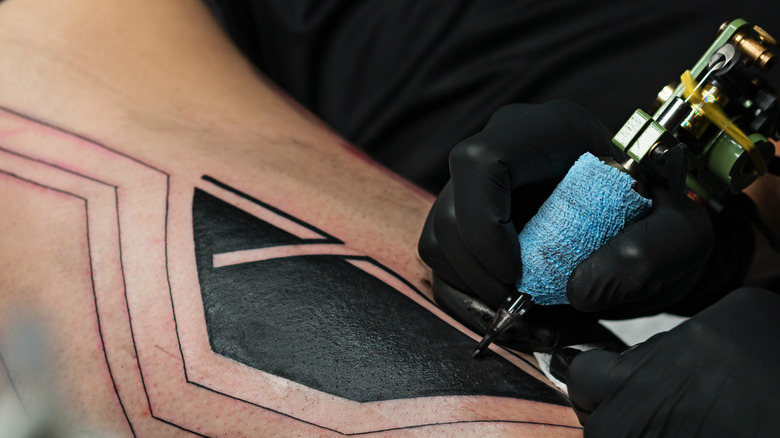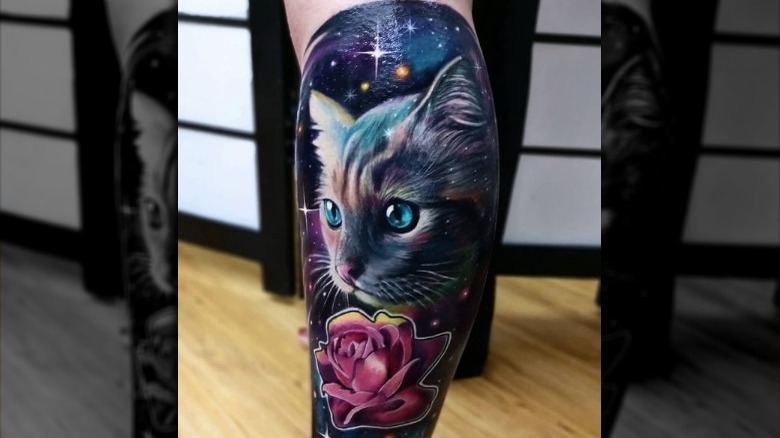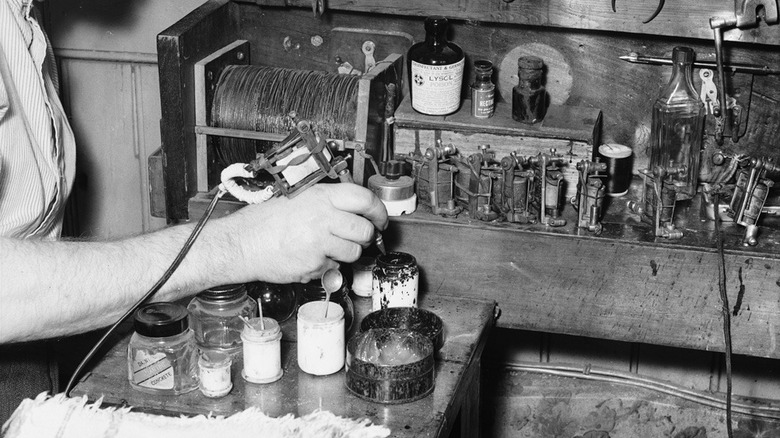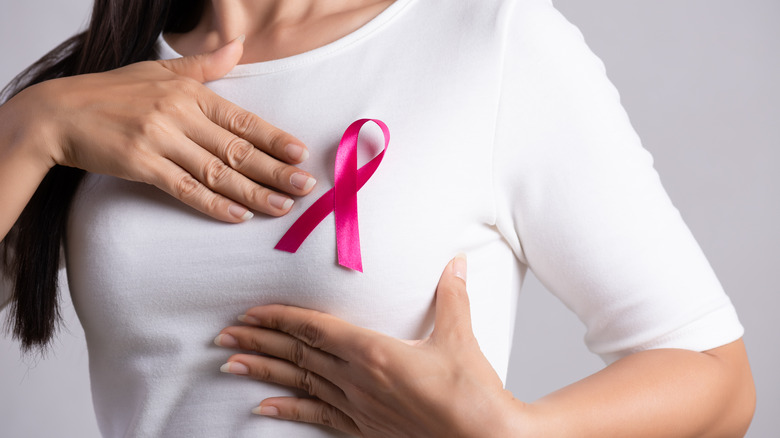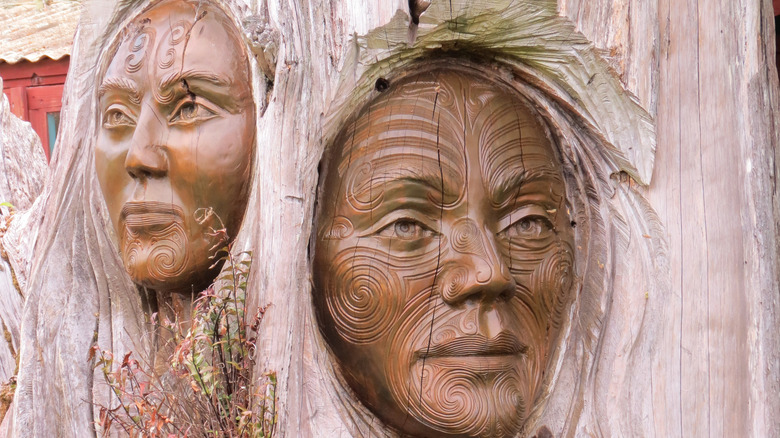Inside The Amazing Artistry Of 3D Tattoos
It's not an exaggeration to say that tattoos are among the world's oldest, and most widespread, forms of ritual artistry. To Ancient Egyptians, circa 3351-3017 BCE, they likely denoted "status, bravery, and magical knowledge" (per the BBC). Numerous Native American tribes, as the American Indian Heritage Foundation tells us, use tattoos to denote spiritual beliefs, victories, and to identify tribesmen. To the Samoans, as PBS says, tattoos are an integral part of culture, representing a key rite of passage, using traditional tools of boars' teeth fastened to a turtle shell. (The phrase "ta tua" is a Polynesian loanword, in fact, thanks to British explorer James Cook's visit in 1771, per The Telegraph.) In 1993, in the Altai Mountains in Siberia, the 2,500-year-old "Ukok Princess" was found inscribed with mystical, otherworldly steeds, as the Siberian Times states. And the oldest tattoo tools? They're at least 12,000 years old, from areas of modern-day Portugal, Scandinavia, and France, per Interesting Engineering.
Of course, despite all ritualistic and spiritual significance, it's possible that the ancients also simply liked how some tattoos looked. Not every culture has been on board with the whole tattoo thing, but bit by bit, tattoos have not only come into near-universal acceptance, but their aesthetic value has caught up to their traditional relevance. And now, we also have the tools to bring to life some of the most lucid, unbelievable products of human imagination and craft. Enter: the mind-blowing artistry of 3D tattoos.
An optical illusion of shading, gradation, and overlapping patterns
To give you an idea of what we're talking about when we say "3D tattoo," take a peak at some of the reality-shattering work by various artists on Tattoodo, or the hexagram-heavy inking of someone like Jesse Rix from New Hampshire on BoredPanda. (Seriously, prepare to pick your jaw off the floor.) Gone are the days of old-school, sailor-type tattoos (although nothing wrong with those if you dig them), and in are the days of tattoos rivaling the finest photorealistic illustrations sketched on paper, drafted on canvas, digitally painted in Photoshop, and so forth.
So what is a 3D tattoo, exactly? In a general sense, it's a tattoo that "pops" in a 3D way. This means that the illustration itself focuses on the dimensionality of design, features some strong contrasts between foreground and background, and might depict some object pushing forward to the surface of the skin. They require a cosmically deft hand with shading and gradations, and play with space, perception, overlapping patterns, and generally warp your vision like an optical illusion.
3D tattoos can be seen, in a way, as an offshoot of "realism tattoos" (i.e., "photorealism"). As Chronic Ink Tattoos tells us, realism tattoos seek to emulate, accurately, the forms, colors, shapes, lines, and so on, we see in daily life. This is an excessively difficult skill to master, in contrast to abstract or figurative art, and is the reason why so many tattoos of faces, for example, come out disappointing.
A byproduct of technological and artistic evolution
Looking at thousands of years of tattoo history, 3D tattoos are an extremely modern development. Methods of tattooing have varied from culture to culture, but like any other art — or anything that a human being can imagine, in fact — capabilities are bound and defined by tools and technology.
In 1876, Thomas Edison created an "electric pen," which was more like a stencil that you pressed down while a needle poked up and down 3,000 times per minute, as Popular Mechanics tells us. Dubbed a "teletattoograph," it was intended to be used for publishing purposes. Fifteen years later, in 1891, Samuel O'Reilly invented a conspicuously similar "electric tattoo machine" that was, however, an immense improvement in design. It was just as fast as Edison's (3,000 times/minute), but featured a five-needle array that resulted in an approximately 25x-faster job for tattoo artists. Artists could work more efficiently, with less pain, less blood, and opened the pathway to a world of advanced tattoo artistry such as 3D tattoos. Traditional tattooing methods, like Bornean tapping (viewable on Satapak Studio), Maori "moko" (described on Zealand Tattoo), and Hawaiian hand-tapped "kakau" (on Hawaiian Magazine), were (and are) often excruciating.
Almost immediately, by the early 1900s, as Duke University's The Chronicle overviews, shows and circuses started featuring highly tattooed individuals. Unfortunately, these were meant as "freak shows," and typically fetishized tattooed women. The path to wider acceptance (particularly in the modern West), though, and evolution in artistry, was laid.
A compassionate choice for breast cancer survivors
Advances in tools, tattooing methods, and artistry haven't merely resulted in some cool-looking "tats," though. Today's 3D tattoos have become a part of an entire industry of medical professionals who are using their skills to bring comfort and support to survivors of breast cancer. Mastectomies and lumpectomies — either full or partial removal of tissue, including nipples — can leave people feeling defeated, ashamed, or somehow "less of a woman," which are notions that 3D tattoo artists are working very hard to dispel, in tandem with surgeons.
Breast reconstructive surgery is a highly complex, costly surgical procedure, as Breast Cancer outlines, involving options like implants vs. flap surgery, whether to shape the tissue to resemble the form of a nipple, and so on. At the end of it, artists like Vinnie Myers, former Army medic and "the Michelangelo of nipple tattoos," stand ready to shock and amaze with 3D tattoo nipples so realistic they've fooled doctors, as Washingtonian states. Tara Williamson, on the other hand, is a certified nurse turned 3D tattoo artist after her own bout with breast cancer. As Pink Ink Tattoo says, she's certified in 3D Areola Complex and scar camouflage tattooing. "Areola Restorative Tattoos (A.R.T.)," in fact, constitute an entire type of technical training, per the BBC.
Of course, many women have also chosen to celebrate the beauty of their post-surgery bodies by adorning their scars or chests with traditional, non-3D tattoos such as watercolors, as Health shows.
A growing industry stemming from human self-decoration
People often ask "how much?" when speaking of tattoos — surgery-related or otherwise — and of course, the answer varies from shop to shop, artist to artist. Each tattoo is — unless you're visiting a parlor best avoided — a bespoke piece of commissioned art; "whatever it takes" is honestly the best answer. Given the staggering amount of skill involved, the difficulties of working with a squishy, malleable flesh canvas, the permanence, the materials (colored works, in particular) and skin tone matching, the health precautions involved, the time it takes to finish (perhaps over multiple sessions), and even the talent necessary to draft an initial design: It makes sense why a 3D tattoo, in particular, can run, on average, $200/hour, per Fash. Like any tattoo, bigger pieces can cost multiple thousands of dollars, as Top Trends Guide outlines.
At present, the tattoo industry generates around $3 billion dollar per year, per Marine Agency Insurance. Barring COVID complications, it's also an ever-growing industry with plenty of high-profile conventions all across the world, as seen on World Tattoo Events.
Tattoos are a part of the grand, immense, human tradition of self-decoration (clothing, jewelry, makeup), and a part of the greater spectrum of body modifications. It's natural for people to challenge themselves to develop novel art forms, such as 3D tattoos, and just as natural for others to want to be involved. Even if you wouldn't get one yourself, the talent on display is undeniable.
